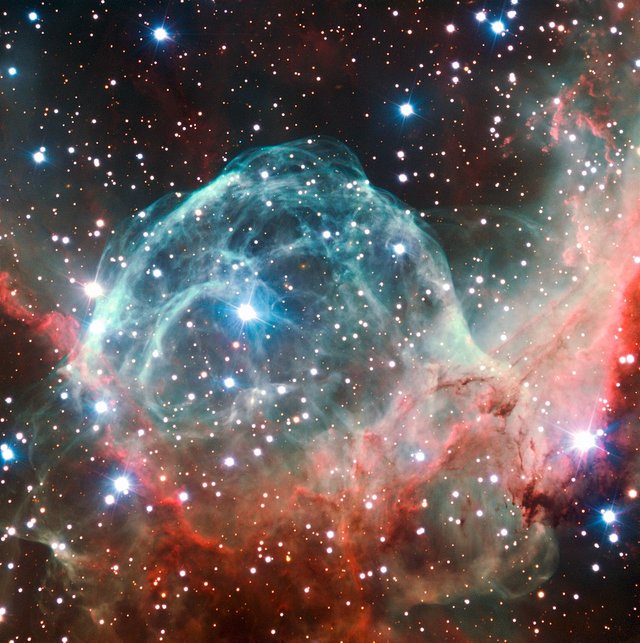Astronomical observations #22: Thor's Helmet Nebula (NGC 2359)
Welcome to the next part of Astronomical Observation. It is time for another, less known nebular object, which is worth seeing by an amateur telescope. NGC 2359, or so-called Thor's helmet or the second name: The Duck Nebula. This isn't a large emission nebula that is found in the constellation of the Canis Major. Below is a photo from the VLT telescope belonging to the European Southern Observatory.

By European Southern Observatory/B. Bailleul link [CC BY 4.0 licence]
NGC 2359 was discovered in 1785 by William Herschel. This object lies approximately 15,000 light years from Earth. The nebula is reminiscent of a helmet with two horns, which is why they speak Thor's Helmet. In fact, it is a cloud of gas, expanding due to the power of the solar wind emitted by a bright star with a large mass. It is the Wolf-Rayet Star. This is a very hot stellar giant that is at the final stage of its evolution. The life of this star will probably end with a supernova explosion. NGC 2359 has a distinct and fibrous structure. Its color is caused by the emission of oxygen, which is a component of the gas cloud of the nebula. The object's brightness is +10.8 magnitude, so it isn't visible to the naked eye. The nebula occupies an area of 9 X 6 arc minutes in the sky. Real size of the nebula in space is about 30 light years. The 15 X 70 binoculars under a dark, rural sky are perceived as a small foggy spot. In a telescope with a diameter of 6 inches (15.24 centimeters), we can already see the so-called horns of the helmet. However, in a large instrument with a diameter of 12 inches (30.48 centimeters), the following views are available, without colors. To see the delicate colors in visual observations, you need a giant telescope with a diameter of at least 20 inches (50.8 centimeters). This is basically the upper limit when it comes to the size of amateur telescopes.

By Roberto Mura link [Public domain]
As you can see, an amateur astronomer can see a lot, having equipment within 1-2 wages. The worse problem of the present times is the increasingly inferior quality of the sky, which remains truly black and clean only tens of kilometers from cities, which are more and more. Finding a good, dark place allows you to see a small telescope as much as watching the great sky in the suburban sky. I encourage everyone to observe the night sky and buy a binocular or telescope to start the adventure with amateur astronomy. This great hobby allows you to see that the Earth is only a small point in the huge universe. Every cloudless night above our heads a window opens to the cosmos that surrounds us. You can also see the huge space surrounding our planet. I encourage you to follow my profile, you will find here a lot of advice on amateur astronomy.
Greetings to lovers of Astronomy!
References:

I have a telescope of my own. A 15 cm Newtonian. I forgot all the other stuff because I havent used it for a long time. I found it super difficult to locate anything in the sky. Do you have any tips for a newbie like me?
It's best to learn the sky using a map and binoculars. The telescope has a small field of view and finding objects can be difficult. The most important is to put on a long focal length eyepiece and set the finder correctly. The finder should have a minimum of 8 × 50 parameters. Poor finder, badly adjusted, doesn't allow good observation. Finding objects should be easy and pleasant.
I might just invest into a very good binocular with maybe a tripod so I can start observing.
I always wanted to also do some astrophotography. Do you think this is possible at an entry level with a binocular.
Astrophotography is a complicated matter and requires a large budget. Binoculars 10 X 50 or 15 X 70 with a tripod are nice visual observation devices for starters.
Astronomy diffidently humbles you. :-)